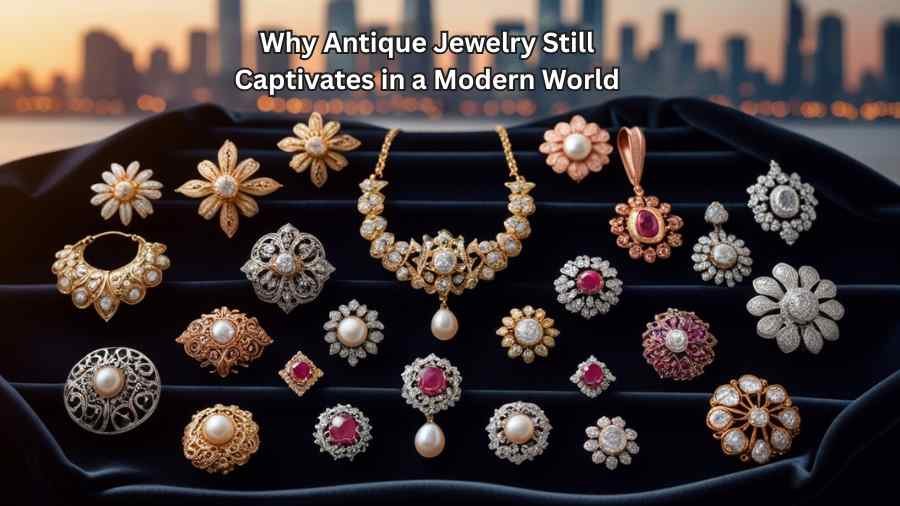Why Antique Jewelry Still Captivates in a Modern World

There’s something magnetic about antique jewelry. Maybe it’s the weight of history. Maybe it’s the craftsmanship. Maybe it’s the idea that each piece has lived a life before yours.
Whatever the reason, antique jewelry has a soul. It carries stories. It holds memories.
And unlike mass-produced designs, these treasures can’t be duplicated.
They’re one of a kind.
What Counts as “Antique”
Let’s be clear. Not all old jewelry is antique.
By definition, antique jewelry is over 100 years old. That means it was made before the 1920s.
Pieces from the 1930s to 1980s? Those are vintage, not antique.
The distinction matters because antique pieces were crafted differently. They were made before modern machinery, before mass casting, before shortcuts.
Every detail was done by hand.
That’s why when you look at an antique ring or brooch, you can see tiny imperfections. Those imperfections are proof of authenticity.
They’re fingerprints of history.
The Eras That Define It
Antique jewelry spans several iconic periods. Each has its own personality.
Here’s what sets them apart:
Georgian Era (1714–1837)
- Rare and highly collectible.
- Handmade completely—no machines.
- Designs often featured closed-back settings, foil under stones, and motifs like bows, flowers, and hearts.
- Metals were typically 18k gold or silver.
These pieces glow differently. The craftsmanship is unmistakable.
Victorian Era (1837–1901)
This era changed everything. Queen Victoria influenced jewelry styles throughout her life.
- Early Victorian (Romantic): floral motifs, lockets, serpents.
- Mid-Victorian (Mourning): darker gems, black enamel, jet, onyx.
- Late Victorian (Aesthetic): diamonds, bright gemstones, lighter designs.
The emotional range of Victorian jewelry is unmatched. Each phase tells a story of love, loss, and rebirth.
Art Nouveau (1890–1910)
Nature meets fantasy.
- Flowing lines.
- Soft enamels.
- Female forms and mythical creatures.
- Materials like horn, ivory, and glass.
It’s romantic, fluid, and whimsical. Art Nouveau jewelry feels like wearable art.
Edwardian Era (1901–1915)
Refinement and lace-like detail.
- Platinum became popular for the first time.
- Filigree work dominated.
- Designs were light, airy, and elegant.
Think pearls, diamonds, and delicate scrollwork. Edwardian jewelry has a regal, ethereal quality.
Why Antique Jewelry Feels So Different
Antique pieces weren’t rushed.
Every ring, bracelet, and brooch took time—days or even weeks.
Goldsmiths, engravers, and stone cutters worked by hand. They relied on skill, not software.
That’s why antique jewelry feels alive.
You can sense the human touch in the curves and settings. You can feel the weight of real materials.
Modern jewelry is perfect. Antique jewelry is soulful.
The Materials That Tell a Story
The materials used in antique pieces were chosen carefully, often symbolically.
- Gold: Always solid, never plated. The hue varies—soft rose gold in the Victorian era, rich yellow in Georgian pieces.
- Silver: Common in Georgian and early Victorian designs, often oxidized for contrast.
- Platinum: Introduced during the Edwardian period for its strength and whiteness.
- Gemstones: Natural. Unheated. Unenhanced. That’s rare today.
You’ll also find old cut diamonds—rose cuts, mine cuts, and cushion cuts.
These stones sparkle differently. They have depth, not just brilliance.
And that’s part of the magic.
The Symbolism Hidden in Every Piece
Antique jewelry is full of secret messages.
Victorians especially loved symbolism. They used gemstones and motifs to communicate emotions.
Some examples:
- Snakes: Eternal love and wisdom.
- Hearts: Obvious but powerful—affection and devotion.
- Hands: Friendship or faith.
- Forget-me-nots: Remembrance.
- Lockets: Protection of loved ones, often holding hair or portraits.
Even colors had meaning. Blue for loyalty. Red for passion. Green for new beginnings.
That’s why antique jewelry is often more than an accessory—it’s a personal language.
The Beauty of Patina
If you’ve ever held an antique ring, you’ve seen it.
That soft glow. The way the gold seems to have a memory.
That’s patina—the natural sheen that develops over time.
It’s not dirt. It’s not wearing. It’s history.
Polishing it away would erase part of its soul.
Collectors know this. They love the subtle signs of age—tiny scratches, faint tarnish, uneven engraving.
Those details make each piece authentic.
Why Antique Jewelry Is Sustainable
In an age of fast fashion, antique jewelry is the opposite.
It’s recycled luxury.
No new mining. No mass production. No waste.
Every time you buy an antique piece, you’re giving new life to something that already exists.
You’re extending its story.
That’s the most sustainable way to buy fine jewelry.
And let’s be honest—it feels good to own something with a past.
The Hunt for Authenticity
Finding real antique jewelry takes patience.
The market is full of reproductions. Some are obvious fakes. Others are skillful copies.
Here’s how to spot the real thing:
- Check hallmarks. Many antique pieces have stamps indicating metal purity or maker’s marks.
- Look at the craftsmanship. Handmade settings, uneven prongs, old-cut stones—all good signs.
- Inspect the clasp or hinge. Antique clasps differ from modern ones. Victorian pieces often use “C” clasps or box clasps.
- Ask for provenance. Reputable sellers should be able to explain the history or origin.
If you’re buying from a trusted source like Broken English Jewelry, you can rest easy. They curate verified antique collections—authentic, high-quality, and stunning.
The Emotional Connection
Wearing antique jewelry feels different.
There’s weight to it—not just physical, but emotional.
You think about the person who wore it before you. The events are seen. The love it might have represented.
It’s a link between generations.
And when you wear it, you become part of its story.
That connection can’t be replicated with something brand-new.
Styling Antique Jewelry Today
You don’t need to wear antique jewelry like you’re in a period drama.
Mix it up.
Here’s how to make it modern:
- Pair a Victorian ring with a minimalist gold band.
- Stack Georgian bracelets with a sleek modern cuff.
- Layer a delicate Edwardian pendant with a chunky chain.
- Combine antique brooches on a denim jacket or blazer.
Antique pieces bring depth to contemporary outfits.
They add a touch of character that nothing else can.
Investment Value
Let’s talk money.
Antique jewelry isn’t just sentimental—it’s valuable.
Why? Because they’re rare. You can’t make more 1800s rings.
As long as you buy authentic pieces, they hold or increase in value over time.
Especially items from famous makers or unique eras.
Pieces with original stones, intact settings, and known provenance are particularly sought after, but here’s the real value: you’re buying craftsmanship and history that can’t be replicated.
That’s worth more than trendy jewelry any day.
How to Care for Antique Jewelry
Old doesn’t mean fragile—but it does mean delicate care.
Follow these rules:
- Avoid harsh cleaners. No ultrasonic machines or chemicals.
- Store separately. Use soft pouches or lined boxes.
- Clean gently. Warm water, mild soap, soft brush.
- Remove during heavy activity. Protect from knocks and heat.
And always have antique pieces checked by a jeweler who understands vintage work.
The Stories That Stay
Every antique piece has a past. Some were wedding gifts. Some were mourning tokens. Some were passed down through generations quietly, without fanfare, but all of them carry emotion.
That’s what makes them magical.
When you wear an antique locket, you’re holding a piece of someone’s joy. Or sorrow. Or hope.
You’re continuing a story that started long before you.
And that’s what makes antique jewelry timeless.
Final Thoughts
In a world obsessed with newness, antique jewelry reminds us of endurance.
It’s proof that beauty lasts. That craft matters. That emotion can be forged in gold and gemstones.
When you wear an antique ring or pendant, you’re not following a trend. You’re embracing history.
You’re saying: I value the story behind the shine.
So next time you’re drawn to a piece that looks a little different—one that whispers instead of shouts—listen.
It might just be an antique calling your name, because some treasures aren’t meant to be brand new.
They’re meant to be rediscovered.



